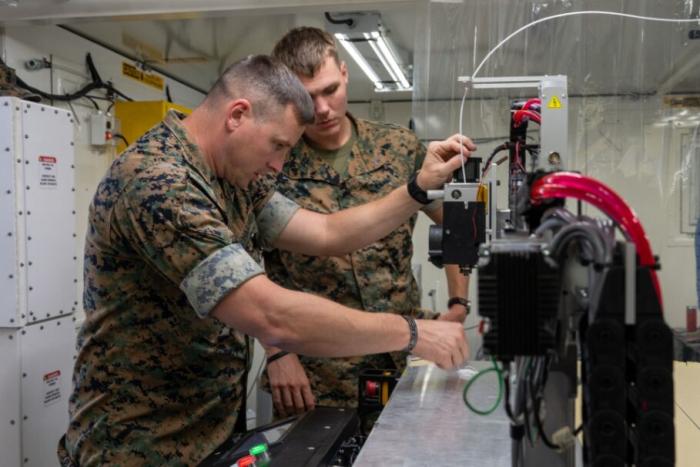Last November, the Royal Australian Navy (RAN) hosted its annual training exercise, Autonomous Warrior (AW23). Among other representatives of Australia’s military allies that participated in AW23 were the US Office of Naval Research (ONR), its international arm, ONR Global, and the US Marines.
Located at HMAS Creswell, the RAN’s training facility in southeastern Australia, AW23 tested a wide range of cutting-edge naval technologies, such as AI and machine learning (ML), and unmanned and autonomous systems. One of the technological capabilities demonstrated by the ONR and the Marines was deployable additive manufacturing (AM), enabled by the ONR-sponsored Expeditionary Fabrication System (XFAB).
The XFAB project was initiated sometime around 2017, with the first XFABs delivered to Marine bases around the world in 2022. Every XFAB is housed in a collapsible 20’-by-20’ shipping container and includes a suite of manufacturing equipment, initially planned to include two Lulzbot TAZ Workhorse 3D Printers, two Markforged X7 3D printers, one 3D Platform 3000 Series Printer, and one Epilog Fusion Pro 32 Laser Cutter and a Quantum FAROArm S 3D laser scanner. At AW23, the US Marines “printed components such as medical tools, latches and hinges, propellers, impellers, and antennae.”
In a press release about the demonstration of the XFAB during AW23, Dr. Jennifer Wolk, a division director in ONR’s Sea Warfare and Weapons Department, said, “In terms of readiness and sustainment, the XFAB will help Marines reduce their logistical impact by enabling that point-of-need manufacturing. Sometimes you don’t know what’s going to break or need replacing, so the XFAB can be a true game changer for warfighters in the field.”
Durga Nanan, an ONR Global science advisor with III Marine Expeditionary Force, said, “In an exercise like AW23, US Marines can conduct training with the XFAB, get more exposure to it and become even more proficient in harnessing its capabilities. They also can share tactics, techniques, protocols and lessons learned with their Australian counterparts — most of which are based on commercial and industry standards and are not proprietary.”
According to the ONR, use of the XFAB at AW23 was meant to demonstrate the sort of ability required for mastery of the “emerging naval concept known as Expeditionary Advanced Base Operations (EABO).” This entails “deploying small but highly mobile units to isolated locations… potentially in an adversary’s weapons engagement zone, in response to an evolving threat when no other U.S. military assets are available.”
Moreover, incorporation of the XFAB into AW23 (and the demonstrations of emerging technologies at AW23, more broadly) reflects a focus on some of the most critical considerations highlighted in the National Defense Industrial Strategy (NDIS) released in January. In addition to the DoD’s increasing focus on defense industrial base (DIB) resilience, the XFAB and the other technically-based exercises at AW23 encapsulate the NDIS’s attention to international partnerships — in this case, specifically the trilateral partnership between the US, the UK, and Australia, referred to as AUKUS.
Finally, such joint exercises are especially crucial in the context of Operation Prosperity Guardian, the response to the Houthi attacks on Red Sea maritime traffic, an endeavor led by the US and participated in by the other two members of AUKUS. Although the US military certainly has plenty of assets in the Middle East, honing of the principles related to EABO will be vital to the already-emerging next phase of the turmoil related to the Red Sea. This involves the resurgence of piracy surrounding the Horn of Africa, an area where the members of Operation Prosperity Guardian will find themselves far more isolated.
Subscribe to Our Email Newsletter
Stay up-to-date on all the latest news from the 3D printing industry and receive information and offers from third party vendors.
Print Services
Upload your 3D Models and get them printed quickly and efficiently.
You May Also Like
3D Printing News Briefs, June 11, 2025: Sustainability, Automotive Tooling, & More
We’re starting with sustainability news in today’s 3D Printing News Briefs, as EOS has strengthened its commitment on climate responsibility, and Zestep is making 3D printing filament out of eyewear...
3D Printing 50 Polymer Stand-In Parts for Tokamaks at the PPPL & Elytt Energy
Of all the world’s things, a tokamak is one of the hardest, most complex, expensive and exacting ones to make. These fusion energy devices make plasma, and use magnets to...
3D Printing News Briefs, May 17, 2025: Color-Changing Materials, Humanoid Robot, & More
We’re covering research innovations in today’s 3D Printing News Briefs! First, Penn Engineering developed 3D printed materials that change color under stress, and UC Berkeley researchers created an open source,...
Firehawk Aerospace Partners with JuggerBot 3D, Gets $1.25M from AFWERX for 3D Printed Propellants
Texas-based Firehawk Aerospace, an advanced energetic materials firm that works with aerospace and defense applications, announced a strategic partnership with JuggerBot 3D, an Ohio-based large-format 3D printer manufacturer. Together, the...



































